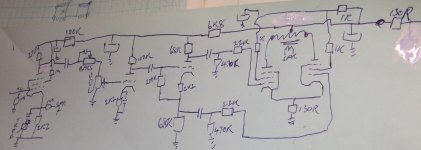I've looked over a bunch of schematics, and I have always liked the simplicity of the concertina PI. I am thinking about the 6GF7A as a candidate. It has a gain section similar to the 12AT7. I would like to breadboard the front end before commiting to it.
So, how do you load it for testing? Use a static resistor of around 100K across the output like you would load test the line kevel output of a preamp?
Thank you!
So, how do you load it for testing? Use a static resistor of around 100K across the output like you would load test the line kevel output of a preamp?
Thank you!
You want to use it to drive a push pull output stage. Its load looks like a capacitor (Cg) in parallel with the grid bias resistor. So there's your test load. Actually two. Take in account the maximum resistance your output tubes will allow. And of course add your coupling capacitor.
What, exactly, are you testing for here? The cathodyne is pretty idiot proof if you've drawn up your loadlines correctly. As long as you don't overload it, the AC balance is guaranteed. If you're concerned with output swing, that's pretty much in line with the loadline analysis.
Hi Miles,
I was going to build a breadboard to see if I can get enough voltage swing to drive a PP 6550.
I also want to see what the square waves look like at various frequencies. The 6GF7A may not be a nice driver at the end if the day. I would rather know that try it in a final amp project and get stuck.
I was going to build a breadboard to see if I can get enough voltage swing to drive a PP 6550.
I also want to see what the square waves look like at various frequencies. The 6GF7A may not be a nice driver at the end if the day. I would rather know that try it in a final amp project and get stuck.
Actually, it will do fine as a driver as long as you're careful to load both sides equally (including capacitance from your scope probes!). Higher gm is better, but 6CG/FQ/SN7 is good enough for all but the highest capacitive loads.
To get enough swing, you'll want lots of B+.
To get enough swing, you'll want lots of B+.
If you want to use a "concertina" phase splitter with KT88s or 6L6s, use a MOSFET. FETs can swing closer to the B+ rail than triodes can. Also, the practical transconductance of many power MOSFETs is in the 10s of mA./V. That's good insurance against slew limiting due to a loop NFB induced HF error correction signal, along with great ease in driving control grid circuitry capacitance.
High gm is not required for better slew rate. To increase slew rate you need to increase current (increasing gm actually reduces slew rate, for a given current). In other words, a low-ra tube is attractive when high slew rates are needed, because low-ra tubes can in general be operated at higher currents.
I like the idea of 6SN7
(if high voltage I guess ecc99 would not be a good choice)
would it make sense to look for a single triode instead of a twin tube ?
thought of maybe the 2A3, but seems a bit expencive for this
how about a tube like the (VT?)56 power triode
When dealing with the 'SN7 and it's electrical equivalents, it's important to distinguish between the increased ratings that apply to the pulse circuitry found in TVs and the lower ratings that apply to analog audio service. IMO, it's best to look at an older data sheet. Notice the 300 V. anode voltage limit. OTOH, the ECC99 has a 400 V. anode limit.
If a HIGH B+ rail voltage is in the picture, consider the IRFBG20 power MOSFET as the "concertina" phase splitter device. The breakdown limit is 1 KV.
Merlin, set up ECC88 and 6SN7 cathodynes at the same current (say, 8mA). Now load each of them with capacitors to simulate Miller effects and drive with a square wave. Which has a faster rise time?
You're right of course. I was thinking of a regular gain stage.
Merlin, set up ECC88 and 6SN7 cathodynes at the same current (say, 8mA). Now load each of them with capacitors to simulate Miller effects and drive with a square wave. Which has a faster rise time?
You're right of course. I was thinking of a regular gain stage.
What is the answer and why is it that way?
What is the answer and why is it that way?
With a regular gain stage, increasing the gm also increases the voltage gain. So although you get more output current per input volt, you also get more output volts per input volt, so the slew the slew rate is unchanged.
But it is worth mentioning that this assumes you are not changing anything else. In practice, triodes with higher gm tend to have lower ra, so you actually get more gm and lower voltage gain, and therefore higher slew rate than for most low-gm triodes.
- Status
- This old topic is closed. If you want to reopen this topic, contact a moderator using the "Report Post" button.
- Home
- Amplifiers
- Tubes / Valves
- Concertina type Phase inverters?
